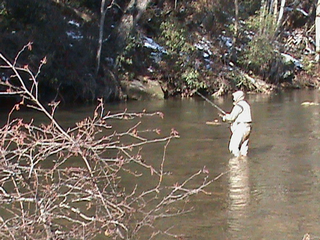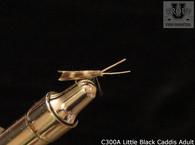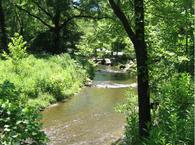
In this class, the student will learn how to cast under low lying branches and will also learn the longer casts needed for large tailwater rivers and the larger rivers such as are found in the Yellowstone National Park. This casts learned in this class are a must before going to Yellowstone.
Painting Casts:
Like the reach cast, the rod is swept to either side after the forward cast is made. Keep the rod tip high on the final forward cast and gently swing it to one side and down to about a 2:30 or 10:30 position immediately after the fly hits the water. The fly will hit the water before any leader or line, and at that very moment sweep the rod to one side to paint the line either upstream or down as the situation may require.
It's much like a curved brush stroke in painting. The difficulty with this cast is getting the fly to hit the water exactly where you want and stay there. Sometimes, making the painting move with the rod will drag the fly away from where I want it to stay. That usually happens if I give too much effort to sweeping the rod to one side. It should be a gentle motion. If there is even a slight breeze, this cast is extremely difficult to execute because the moving air will often sweep the line farther than I want. This one requires perfect timing and feels so good when everything goes right.
Whenever I use the lean, reach, or painting cast, I try to get the fly to land three or four feet above the fish I've targeted. In the time it takes for the fly to float down to the fish I can strip a little more line from the reel and flip the extra line upstream or down to lengthen the float. I believe too many fly fishers think the cast is over when the fly hits the water. It's only the beginning. It's what you do with the line after the fly hits the water that completes the cast. The cast is over when you pick up the line to make another cast.
And that brings me to some advice about picking up or retrieving line during the drift. Once you have determined the length of line you need to present the fly to a specific area, try to keep as much of the retrieved line in your line hand as possible. I've seen fly fishers with as much as ten yards of line flowing downstream in a big loop.
Then, when they pick up the line and fly to make another cast, they have to make three or four false casts to regain control of the line and its speed to make another cast. All this time the fly is in the air and not on the water. Keep as much line as possible in your line hand, lower the rod tip to the surface, and as you quickly raise the rod tip, yank the line toward you with your line hand with a very quick tug. Allow some line to shoot during the backcast, change the rod direction toward your target area, execute a sharp forward cast, and shoot the remainder of the line during the forward cast.
This is impossible to do with a long loop of line hanging in the water. This pickup and forward cast will always present the fly a little farther upstream than you intended, so you must aim for a spot that is about two or three feet below where you really want the fly to land. Like everything else in fly fishing, it takes a little practice. Generally speaking, your fly will go where your thumb is pointing. To finish this cast you must apply a little reach technique to throw the line up- or downstream of the main current between you and the fly. If I need to really drop the fly on a dime, I usually make one false forward cast to make sure the direction of the fly and line is absolutely perfect; then I shoot the extra line to put the fly into a very tight area.
This is best accomplished by keeping the rod and line loop as vertical as possible. Sometimes, especially when fishing midge adults, we need to place the fly so that it will float down to the trout in line with the middle of its nose. Trout won't usually move very far to either side to eat a tiny midge.
Sometimes you simply must cast upstream. It's almost mandatory when you're fishing small streams where there is no room to stand to one side or when you are fishing pocket water in a little mountain stream. Maintaining line control is crucial in either case. Both situations are good times to use a roll cast pickup before you make your next forward cast. It's really easy to do. Execute the beginning of a roll cast, but as the fly comes forward as it normally would on a roll cast, swiftly bring the rod to the rear the same as you would for a normal backcast. You'll get an acceleration of line speed and will easily be able to shoot ten or more feet of line on the forward cast with no false casting.
Water haul cast:
Another way to get accelerated line speed is with a water haul. This cast is especially useful in windy conditions when you need to drive a fly directly into the wind or when you are casting heavily weighted streamers long distances. A water haul in either case will allow you to cast far greater distances without making several false casts to extend line.
Cast as far as you comfortably can and allow the forward cast to land on the water. Immediately lower the rod tip to the water's surface and strip in any loose line with your line hand at the same time. Then abruptly raise the rod to the backcast position while yanking the line with your line hand, and allow some line to shoot to the rear. Briskly bring the rod forward while giving the line a yank with your line hand. You'll be able to shoot a fourteen-inch or smaller loop for greater distance simply because the surface drag on your fly and line as you pick it up will generate a great deal of line speed. It's basically a double haul that is executed after one of the forward casts lands briefly on the water. Once again, it's a little noisy and requires a little extra strength and good timing. If you do a lot of big water fishing, you should practice this one until it consistently works for you. Sometimes you simply must be on the wrong side of the stream. It's a position where the stream is on your left and the bank is on your right (for right-handers). You want to cast upstream, but there are bushes that won't allow a normal over-the-shoulder cast. I try to solve this by facing the center of the stream and casting the fly downstream, then reversing the line direction to present the fly upstream. It amounts to a cross-body cast. You'll probably not be as accurate as you'd like, but with a little practice you can make it work.
Depending on the length of the cast, I always try to keep all the retrieved line in small loops in the palm of my line hand but never wrapped around my thumb and fingers. It's a simple matter to make a loop over your thumb and little finger and transfer each succeeding loop into the palm of your hand by sliding your thumb and fingers out of the loop and folding it down to your palm with your first and second fingers. This creates three- to four-inch loops piled on top of each other. Then, when you go to shoot a little line, the coils will whisper from your hand much like spinning line from a reel. Like all things, it requires a little practice but will soon become an automatic reflex. You'll be amazed at how much line you can shoot on the forward cast with only one backcast.
There is a cast I learned from my old friend Koke Winter, the master of weird casts. It comes in handy when you're fishing large, fast rivers where the fish are also large and fast. I'm thinking of places like the Madison and Yellowstone rivers outside of Yellowstone National Park. On these rivers you must often cast across a stream forty to sixty feet or more and land the fly on the far side of a series of variable speed currents. Immediately after the fly lands on the water, quickly strip (or have ready) five or six feet of line from the reel, lift the rod tip slightly to one side, and instantly throw a tight roll cast directly toward the fly. It's rather a savage action. You will usually throw a small loop of line near the fly, and that is often just enough line to increase a drag-free drift by as much as three or four feet. It's also possible to throw this smaller loop nearly anyplace between you and the fly to increase the length of a drag-free drift. Just make sure the loop falls to the upstream side of your fly line.
This one really feels good when it works, especially when a big fish takes the fly just before it begins to drag across current. (The described action is much like throwing a loop against the far bank or behind your fly to dislodge it from an exposed tree root or rock. Briskly raise your rod the moment the loop lands behind the fly. The sudden tug in the opposite direction will often free your fly.) Be ready to set the hook when you try this one, because the action of the tight roll cast will often cause the fly to twitch as much as six or eight inches and can trigger a strike when you least expect it.
Another time to use this cast is when you are fishing a large river and need to get your fly under a tree that's too low to the water for any kind of normal cast. It's a variation of a tight roll cast and the roll cast you would use to retrieve a fly stuck in the far bank. Cast the fly to land just short of the target. Then make a tight roll cast with your rod out to your side two or three feet above the water, and throw a fierce forward roll to create a loop no more than two or three feet high. The shallow loop will throw the fly back under the branches. It's not pretty to watch but can be most effective. There will be a little noise as you rip the line off the water and shoot the loop forward.
Note: This class is based on excerpts from Fly Fishing with AK a Stackpole Books publication.
Review Class 422 for previously mastered casts. Continue to practice, practice makes perfect.
Read these books by A. K. Best
Fly Fishing with A. K. Best by Stackpole Books





